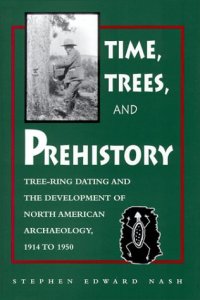
Ebook: Time Trees & Prehistory
Author: Stephen Edward Nash
- Year: 1999
- Publisher: University of Utah Press
- Edition: 1St Edition
- Language: English
- epub
Dendrochronology, the science of assigning precise calendar dates to annual growth rings in trees, provided archaeologists with accurate dates at a time when North American archaeologists had no absolute dating techniques available to guide their analyses. TIME, TREES, AND PREHISTORY examines the growth, development, application, and interpretive implications of North American archaeological tree-ring dating from 1914 to 1950. Once established at the University of Arizona in 1929, archaeological tree-ring dating was practiced at several institutions, some of which saw themselves in direct competition with each other. By 1931 the Museum of Northern Arizona in Flagstaff, the Laboratory of Anthropology in Santa Fe, and the Gila Pueblo Archaeological Foundation in Globe, Arizona had all established their own tree-ring dating laboratories. By the end of that decade, intensive efforts were also underway to develop tree-ring dating in Alaska and the American Midwest. Through the analysis of the appropriate institutional archives, this volume chronicles the painstaking research, the trials and tribulations, and the successes and failures of the often famous personalities engaged in tree-ring research at these fledgling dendrochronological institutions. The development of dendrochronology forced archaeologists to radically revise their understanding of the prehistoric past by compressing-by nearly fifty percent-the time scale within which the archaeological record was contained. Basketmaker sites, for instance, were once thought to date some two thousand years before Christ; tree-ring dates demonstrated that these sites dated well into the first millennium. Classic sites in Chaco Canyon and Mesa Verde were once thought to have been occupied for upwards of a thousand years, but tree-ring dates demonstrated that such sites were often built, occupied, and abandoned in just over a century. Other similar changes in temporal scale forced archaeologists to reconsider their interpretations of the rate of prehistoric cultural change, population growth, and the degree of social and political complexity in the Southwest. TIME, TREES, AND PREHISTORY examines archaeological practices of the 1920s, 1930s, and 1940s, and demonstrates that tree-ring dating set the stage that enabled revolutionary developments in archaeological method and theory in succeeding decades.
Download the book Time Trees & Prehistory for free or read online
Continue reading on any device:

Last viewed books
Related books
{related-news}
Comments (0)